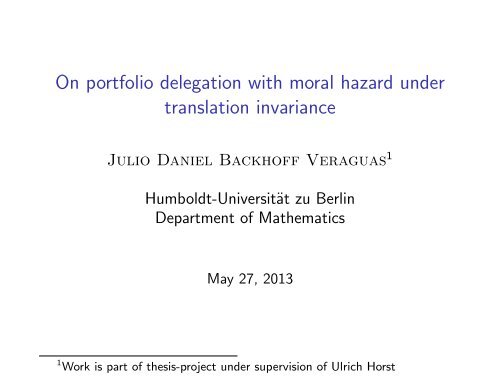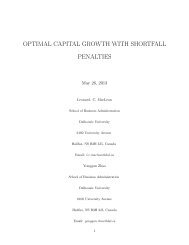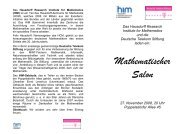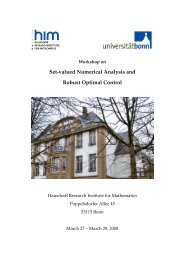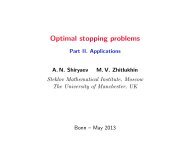On portfolio delegation with moral hazard under translation ... - HIM
On portfolio delegation with moral hazard under translation ... - HIM
On portfolio delegation with moral hazard under translation ... - HIM
Create successful ePaper yourself
Turn your PDF publications into a flip-book with our unique Google optimized e-Paper software.
<strong>On</strong> <strong>portfolio</strong> <strong>delegation</strong> <strong>with</strong> <strong>moral</strong> <strong>hazard</strong> <strong>under</strong><br />
<strong>translation</strong> invariance<br />
Julio Daniel Backhoff Veraguas 1<br />
Humboldt-Universität zu Berlin<br />
Department of Mathematics<br />
May 27, 2013<br />
1 Work is part of thesis-project <strong>under</strong> supervision of Ulrich Horst
Overview<br />
• Portfolio <strong>delegation</strong> as a Principal-Agent game<br />
• Reduction to a single recursion/BS∆E<br />
• Existence of optimal contract and strategies<br />
• Markovian setting<br />
• A related problem and continuous-time analog<br />
• Further research
Context<br />
• There is an investor (P) and a manager (A)<br />
• (P) delegates management of her investments to (A)<br />
• (A) has to be rewarded for his effort, which is costly<br />
• (P) designs a contract specifying payment structure of deal<br />
• (A) acts in his own self-interest; has an opportunity cost R<br />
• (P) wants to maximize her own well-being<br />
• (P) should not monitor/observe everything (A) does
Setup<br />
• Time is discrete: t ∈ T := {0, .., .T }<br />
• Uncertainty is described by (Ω, F , {F t }, P)<br />
• The N-dim. price process {P t } is F t −adapted<br />
• At time t ∈ T, (A) and (P) have access to F t<br />
• (A) has fixed initial cash endowment W 0
The financial market, wealth and cost<br />
• (A) trades in the financial market comprising the N assets<br />
<strong>with</strong> price at time t equal P t<br />
Denote ∆˜P t+1 := diag(P t ) −1 ∆P t+1<br />
• Choosing a strategy {A t }, the (A) generates wealth for (P):<br />
∆W t+1 = A t · ∆˜P t+1<br />
• Associated <strong>with</strong> each strategy {A t } is a cost (of effort)<br />
C := ∑ t<br />
c t (A t )∆t
Payments and preferences<br />
• The payment from (P) to (A) (contract) is assumed linear:<br />
T∑<br />
−1<br />
S = ε T + β t · ∆W t+1<br />
where ε T is F T -measurable (not just F 0 -measurable; key!)<br />
• Terminal wealth of (P), respectively (A), is<br />
0<br />
W T − S respectively S − ∑ t∈T<br />
c t (A t ) · ∆t<br />
• At each time t ∈ T, (A) and (P) maximize conditionally<br />
concave, <strong>translation</strong> invariant, time-consistent, ... preference<br />
functionals 2 U a t , U p t : L 0 (F T ) → L 0 (F t )<br />
2 See work of Cheridito, Horst or Kupper
Comments<br />
• The Agent’s optimization problems is:<br />
Find an optimal strategy taking into account the<br />
contractual agreements.<br />
• The Principal’s problem is<br />
Find an optimal contract taking into account<br />
agent’s reaction function and outside option.<br />
• For an optimal contract it will be enough to depend on final<br />
wealth rather than its whole path 3<br />
• Main idea: make utility of (A) a control variable for (P) 4<br />
3 As obtained by Ou-Yang<br />
4 As done by Sannikov
The Agent’s problem<br />
• (A)’s problem is a standard conditional optimization problem<br />
• Let H a t<br />
utility enjoyed by/promised to (A) from t ∈ T on:<br />
H a T = ε T<br />
H a t = ess sup<br />
A∈L 0 (Ft ) N {U a t (H a t+1 +βtA·∆˜P t+1)−c t(A)∆t}<br />
• Formally if H a t+1 = E ( H a t+1 |F t)<br />
+ x<br />
a<br />
t+1 , we get a BS∆E:<br />
∆Ht+1 a =xa t+1 − ess sup {U a<br />
A∈L 0 (Ft ) N t (xt+1 a +βtA·∆˜P t+1)−c t(A)∆t}<br />
• Controlling ε T steers H a (hence x a ) and makes H a 0 = R.<br />
Therefore, reinterpret BS∆E as an S∆E starting from R
Attainability<br />
Theorem (Existence of optimal strategies)<br />
Assume c t (·) is convex and lsc, Ut<br />
a is seq-usc, and suppose<br />
Ht+1 a < ∞ has been found. Then, Ha t is attained by some<br />
A ∗ ∈ L 0 (F t ), <strong>under</strong> any of these conditions:<br />
• U a t (·) is sensitive to large losses and c t (·) ≥ κ t + λ t | · |<br />
• U a t (·) ≤ K t + E (·|F t ) and<br />
c<br />
lim t(A)<br />
|A|→±∞<br />
|A|<br />
= ∞<br />
Remark: Idea is to use No-Arbitrage arguments plus randomized<br />
Bolzano-Weierstrass
The Principal’s problem<br />
• (P)’s problem is a constrained conditional optimization one<br />
• (P) choses strategies and contract subject to two conditions:<br />
• incentive compatibility (IC)<br />
• individual rationality (IR)<br />
• (P)’s problem consists in solving for all time s ∈ T:<br />
u p s =<br />
ess sup Us p (W T − S(A))<br />
ε,(β k ) T −1<br />
k=0<br />
A k ∈arg max H<br />
k<br />
a<br />
H<br />
0 a ≥R<br />
The first constraint is the (IC), the second the (IR) constraint.
The Principal’s problem<br />
• If A is optimal for (A), then the value of the contract is<br />
S = H a 0 +∑ {c t(A t)∆t+H a t+1 −Ua t (H a t+1 +βtAt·∆˜P t+1)<br />
+β tA t·∆˜P t+1 }<br />
• (P)’s utility from t ∈ T on, <strong>under</strong> a given contract is thus:<br />
Ut<br />
p ( ∑<br />
)<br />
s≥t Ua s (...)−c s(A s)∆t−(β s−1)A s·∆˜P s+1 −Hs+1<br />
a<br />
• (P) can steer H a by controlling ε T
The principal’s problem<br />
Theorem<br />
Let h p s denote (P)’s optimal wealth from time s onwards. Then:<br />
h p T<br />
= 0<br />
h p t = ess sup U p t (h p t+1 −x−(β−1)A·∆˜P t+1)−c(A)∆t<br />
x∈F t+1 (A,β)<br />
+U a t (x+βA·∆˜P t+1)<br />
and u p 0 = W 0 − R + h p 0
The principal’s problem<br />
• (P) controls (A)’s wealth through x(= Ht+1 a − E ( )<br />
t H<br />
a<br />
t+1 )<br />
• x ∈ F t+1 (A, β) means that when faced <strong>with</strong> contract (β) and<br />
a future wealth prospect x, (A) chooses A<br />
• Problem can be reformulated in terms of (β, A) and<br />
Γ := X + βA · ∆˜P t+1 ∈ L 0 (F t+1 ) alone:<br />
ht p }<br />
= ess sup<br />
{U p t (h p t+1 +A·∆˜P t+1 −Γ)−c(A)∆t+Ut a(Γ) (A,β,Γ)<br />
(A,Γ)∈Ct (β)
Attainability of Principal’s problem<br />
• It is sufficient to consider an unconstrained problem:<br />
V (A,Γ):=U p t (h p t+1 +A·∆˜P t+1 −Γ)−c(A)∆t+U a t (Γ)<br />
• Recall standard convolution problems arising in moles of<br />
optimal risk sharing are of the form:<br />
U p t (Y − Γ) + U a t (Γ)<br />
and this quantity is to be maximized over Γ ∈ L 0 (F t+1 )<br />
• We have complex dependencies/constraints, because<br />
h p t = ess sup {(A,Γ)∈Ct(β)}V (A, Γ)
Attainability of Principal’s problem<br />
Theorem<br />
• Suppose the unrestricted problem ess sup (A,Γ)<br />
V (A, Γ) is finite<br />
and attained at (A ∗ , Γ ∗ ). Then<br />
(<br />
1, Γ ∗ , A ∗)<br />
forms an optimal contract and effort tuple.<br />
• The unconstrained problem has a solution if V (·, ·) ∈ L 0 (F t ),<br />
Ut<br />
a,p (·) = ess inf Z∈L 1<br />
t (F T ) {αa,p t (Z) + E[·Z|F t ]} plus technical<br />
conditions<br />
Remark: Idea is to use Komlos theorem for the Γs and random<br />
Bolzano-Weierstrass for the As
Attainability of Principal’s problem<br />
Theorem<br />
Suppose Ut a,p (·) = 1<br />
γ<br />
U a,p t (γ a,p·) and that U satisfies conditions for<br />
attainability of Agent’s problem.<br />
Then unconstrained problem has a solution, the optimal A ∗ attains<br />
ess sup<br />
{−c(A)∆t + 1 (<br />
])<br />
A<br />
γ U γ<br />
[h }<br />
p t+1 + A∆˜P t+1<br />
where γ = γa γ p<br />
γ a +γ p , and Γ ∗ =<br />
[<br />
]<br />
γp<br />
γ a +γ<br />
h p p t+1 + A∗ ∆˜P t+1 is optimal 5<br />
5 Inspired by a similar result by Barrieu and El-Karoui
Predictable representation property<br />
Definition<br />
The model has the Predictable representation property (PRP) if<br />
there is an adapted m-dimensional (uncorrelated) process M such<br />
that:<br />
L 0 (F t+1 )={z+Z 1·∆P t+1 +Z 2·∆M t+1 :z∈L 0 (F t),Z 1 ∈[L 0 (F t)] d ,Z 2 ∈[L 0 (F t)] M }<br />
and R = (P, M) has the No-Arbitrage property.<br />
Identify Γ ∈ L 0 (F t+1 ), where E[Γ|F t ] = 0, <strong>with</strong> γ ∈ [L 0 (F t )] d+M<br />
Theorem<br />
Suppose the PRP holds as well as the usual mild conditions on Ut a ,<br />
Ut<br />
p and c. If the Us are sensitive to large losses then unconstrained<br />
problem is attained.
Markovian models<br />
Suppose ∆P t+1 = P t [µ∆t + σ∆B t+1 ] 6<br />
Definition (Markovian model)<br />
If the function g(z) := U t (z · ∆B t+1 ) is deterministic, and PRP<br />
holds for B, we say that the problem is Markovian.<br />
• Under suitable conditions we have the following FOCs:<br />
0 = [βµ − ∇c(A)] ∆t + βσ∇g a (γ)<br />
0 = [µ − ∇c(A)]∆t + σ∇g p (σ ′ A − γ)<br />
0 = ∇g a (γ) − ∇g p (σ ′ A − γ)<br />
• Problem reduces to an “unconstrained” one as before and<br />
necessarily (β − 1)[µ∆t + σ∇g a (γ)] = 0<br />
6 This is more related to Ou-Yang’s work
Markovian models<br />
Remark: Optimal ε is of the form k + ∑ γ t ∆B t+1 − ˜W T <strong>with</strong> k<br />
and γs constant and ˜W T the optimal <strong>portfolio</strong> wealth<br />
Remark: If further utilities have same structure,<br />
ε = k −<br />
γa ˜W γ a +γ p T and hence optimal contract has the structure 7<br />
A ↦→ S(A) = k +<br />
Example (Entropic utility function)<br />
γp<br />
γ a + γ p W T A +<br />
γa<br />
γ a + γ p [W T A − ˜W T ]<br />
If uncertainty is spanned by Bernoulli walks and<br />
U t (X ) = − 1 γ log (E t [exp (−γX )]) , then<br />
g(z) = − 1 ( (cosh<br />
γ log −γz √ ))<br />
∆t<br />
7 As in Ou-Yang
A related problem<br />
Suppose contracts had had the form<br />
<strong>with</strong> ε ∈ L 0 (F 0 ) only.<br />
S = ε + ∑ [β t ∆W t+1 + ν t ∆˜P t+1 ]<br />
• (A)’s utility not so readily controllable<br />
• Translation Invariance still useful: we get two BS∆Es<br />
• Conditional optimization problems easier than before: problem<br />
at time t involves only F t −measurable rvs. even <strong>with</strong>out PRP<br />
• Still β t ≡ 1 is optimal if a related unconstrained problem is<br />
attainable
Continuous-time analog<br />
• Define utilities through BSDEs <strong>with</strong> suitable generators:<br />
∫ T<br />
∫ T<br />
U s (X ) = X + g t (Z t ) dt − Z t · dB t<br />
s<br />
s<br />
• By assumption, PRP and Markovianity hold (simpler problem)<br />
• H a and h p satisfy analogous BSDEs, by comparison principle<br />
• Generalizes HJB-approach typical of these type of problems<br />
• Non <strong>translation</strong>-invariant preferences lead to FBSDEs 8<br />
8 See work of Cvitanic et al.
Comments<br />
• Essentially, <strong>translation</strong> invariance makes BSDE-approach<br />
tractable<br />
• With conditional analysis, we can go well beyond classical<br />
utility functions<br />
• The price-driving process can be much general than the usual<br />
ones<br />
• Makes no use of Maximum Principle, which in general is<br />
troublesome
To be better <strong>under</strong>stood<br />
• Explore conditional law invariance and relate to risk sharing<br />
and the problems above<br />
• Study the asymmetric information case directly (through<br />
having different filtrations for (A) and (P))<br />
• Move on to more general continuous-time models; extend<br />
conditional analysis to continuous time<br />
• ...
Thanks


